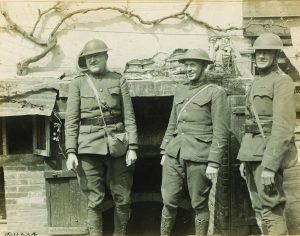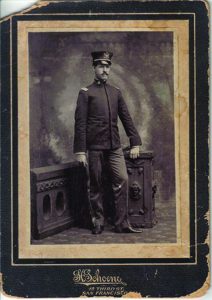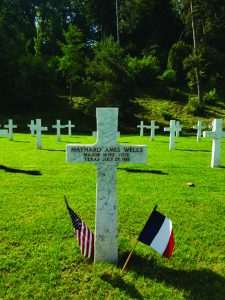
Since the end of the Civil War and continuing through the mid-1960’s, Floyd County has been an exporter of people. Because of this, sometimes it’s easy to lose track of those who made Floyd home. As those who passed through Floyd have been forgotten, important pieces of history are left to be forgotten as well. This is the story of one Floyd County son from the battlefields of World War I.
Maynard Ames Wells was born in December of 1873, the second of thirteen children of Archibald “Archie” Grief Wells (1847-1930) and Sara Maranda “Randy” Altizer (1850-1930). Archie was a former Confederate soldier and served as a pastor of the Methodist Episcopal Church South. Maynard would grow up in the Alum Ridge area of Floyd County until, at age seventeen, he and the family moved to the Auburn (now Riner) area of Montgomery County.
Not a lot is known about Maynard’s early life, but one can imagine as the son of a Methodist preacher in an agricultural area, it consisted of farming and church attendance. Considering his future career advancement, Maynard was probably more well-educated than many others raised in the county during the late 19th century.
In 1899, at age twenty five, Maynard joined the Coastal Artillery as a U.S. Army private. He served in the Coastal Artillery until October 1902, rising to the rank of Sergeant. On October 17, 1902, Maynard was promoted to 2nd Lieutenant and transferred from the 47th Coastal Artillery to the United States 13th Infantry Regiment. Upon his promotion to Second Lieutenant, he was sent to San Antonio, Texas, where he was to reside until going overseas to fight in World War I. While in San Antonio, he would marry his wife, Clara Ross, on November 12, 1911.
Eventually Maynard was promoted and transferred to the 16th Infantry Regiment. In 1914, several factors would lead to rising tensions between America and Mexico. As a result, Maynard’s regiment was placed under the command of General John J. “Blackjack” Pershing and was sent to the Mexican border. Maynard was posted at Camp Cotton in El Paso and for two years did patrol duty on foot along the border. In March of 1916, Pancho Villa famously raided the town of Columbus, New Mexico, as a reaction to President Wilson’s support of a Mexican coup-ďétat. This would lead the President to order an expedition under Pershing to enter Mexican territory to find and capture Villa.

A combined force under Pershing marched into Mexico, finally settling at El Valle, Mexico in June 1916. The infantry had an uneventful eight months on garrison duty, while Pershing’s cavalry units clashed several times with forces of both Villa and Mexican federal troops. After an unsuccessful mission, President Wilson recalled Pershing’s expedition in February 1917.
Maynard, along with the rest of his regiment was then assigned to the 1st Expeditionary Division, also famously known as the Big Red One. They then sailed from Hoboken, New Jersey to St. Nazire, France in June 1917. As they were some of the first Americans to reach France, Wells’ 2nd Battalion was chosen to show the flag in a parade through Paris on July 4, 1917.
Major Maynard Ames Wells trained with the French 47th Division, along with the rest of the American 16th Regiment. The 16th Infantry would become the first U.S. Regiment to fight and suffer casualties in WWI when it successfully repelled a nighttime German raid on November 3, 1917. The 16th’s first major attack was made near Soissons, France in July 1918. Major Wells, as per U.S. military regulations, led his men from the front. The first day of the three-day battle, reflected in Major Wells field notes, detailed that his men came under heavy machine gun fire and had run low on water on a very hot and dry day.
Suffering heavy losses, the American and French forces were halted in a ditch along the Paris-Soissons Road. While in the ditch, Major Wells and troops of the 16th Regiment came under German airplane attack. Dropping bombs, the Germans were able to halt the American-French advance. One of the German bombs exploded near Major Wells. He suffered multiple shrapnel injuries, including injuries to his right hip and both feet. Wells was removed from the field alive, but headquarters was notified that he would not survive.
Several days later, on July 27, 1918, Major Maynard Ames Wells died of his wounds. He would join the thousands of casualties in what would be considered a part of the Second Battle of the Marne. Because American officers led from the front, he would also join many professional officers lost in that battle. He was survived by his wife, Clara, two daughters, his parents, and nine of his twelve siblings.

By the time the “war to end all wars” had ended, Clara had remarried, leaving the decision to repatriate his body to his parents. His parents chose to leave their son in the soil of France. Wells’ remains were relocated in 1921 to the Aisne-Marne Cemetery, Belleau, France where he rests today in Plot B, Row 9, Grave 58, a forgotten son of Floyd County.
The Floyd County Historical Society
217 North Locust Street, Floyd, VA
www.FloydHistoricalSociety.org • 540-745-3247
info@FloydHistoricalSociety.org
